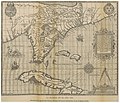Fasciculus:1591 De Bry and Le Moyne Map of Florida and Cuba - Geographicus - Florida-debry-1591.jpg

Mensura huius perspectionis: 775 × 599 elementa imaginalia. Aliae mensurae: 310 × 240 elementa imaginalia | 621 × 480 elementa imaginalia | 993 × 768 elementa imaginalia | 1 280 × 990 elementa imaginalia | 2 560 × 1 980 elementa imaginalia | 4 500 × 3 480 elementa imaginalia.
Sua resolutio (4 500 × 3 480 elementa imaginalia, magnitudo fasciculi: 6.38 megaocteti, typus MIME: image/jpeg)
Historia fasciculi
Presso die vel tempore fasciculum videbis, sicut tunc temporis apparuit.
| Dies/Tempus | Minutio | Dimensiones | Usor | Sententia | |
|---|---|---|---|---|---|
| recentissima | 19:21, 22 Martii 2011 |  | 4 500 × 3 480 (6.38 megaocteti) | BotMultichillT | {{subst:User:Multichill/Geographicus |link=http://www.geographicus.com/P/AntiqueMap/Florida-debry-1591 |product_name=1591 De Bry and Le Moyne Map of Florida and Cuba |map_title=Floridae Americae Provinciae Recens & Exactissima Descriptio Auctore Iacobo Le |
Nexus ad fasciculum
Ad hunc fasciculum nectit:
Usus fasciculi per inceptus Vicimediorum
Quae incepta Vici fasciculo utuntur:
- Usus in nl.wikipedia.org
- Usus in zea.wikipedia.org

